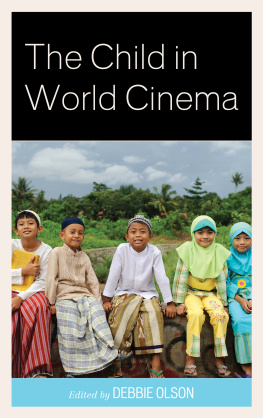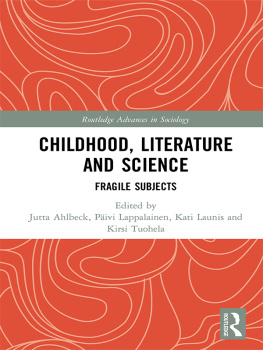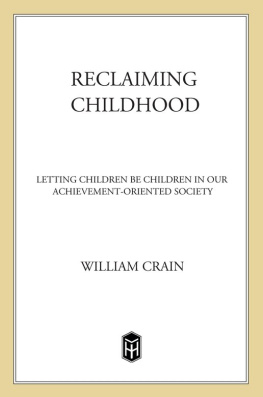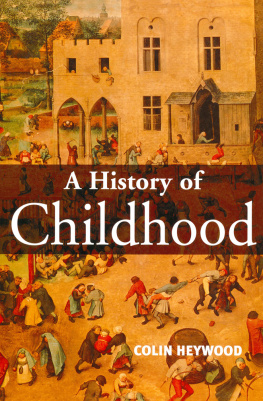The Child inWorld Cinema
Children and Youth in Popular Culture
Series Editor:
Debbie Olson, Missouri Valley College
Children and Youth in Popular Culture features works that interrogate the various representations of children and youth in popular culture, as well as the reception of these representations. The series is international in scope, recognizing the transnational discourses about children and youth that have helped shape modern and post-modern childhoods and adolescence. The scope of the series ranges from such subjects as gender, race, class, and economic conditions and their global intersections with issues relevant to children and youth and their representation in global popular culture: children and youth at play, geographies and spaces (including World Wide Web), material cultures, adultification, sexuality, children of/in war, religion, children of diaspora, youth and the law, and more.
Advisory Board
LuElla DAmico, Whitworth University; Markus P.J. Bohlmann, Seneca College; Vibiana Bowman Cvetkovic, Rutgers University; Adrian Schober, Australian Catholic University, Melbourne
Titles in the Series
The Child in World Cinema
Edited by Debbie Olson
Indians in Victorian Childrens Narratives: Animalizing the Native, 18301930
By Shilpa Bhat Daithota
Misfit Children: An Inquiry into Childhood Belongings
Edited by Markus P. J. Bohlmann
The Rhetorical Power of Childrens Literature
Edited by John Saunders
Children in the Films of Steven Spielberg
Edited by Debbie Olson and Adrian Schober
Girl Talk: The Influence of Girls Series Fiction on American Popular Culture
Edited by LuElla DAmico
Critical Childhood Studies and the Practice of Interdisciplinarity: Disciplining the Child
Edited by Magdalena Zolkos and Joanna Faulkner
The Amricas Award: Honoring Latino/a Childrens and Young Adult Literature of the Americas
Edited by Laretta Henderson
The Child in World Cinema
Children and Youth inPopular Culture
Edited by Debbie Olson
LEXINGTON BOOKS
Lanham Boulder New York London
Published by Lexington Books
An imprint of The Rowman & Littlefield Publishing Group, Inc.
4501 Forbes Boulevard, Suite 200, Lanham, Maryland 20706
www.rowman.com
Unit A, Whitacre Mews, 26-34 Stannary Street, London SE11 4AB
Copyright 2018 by The Rowman & Littlefield Publishing Group, Inc.
All rights reserved . No part of this book may be reproduced in any form or by any electronic or mechanical means, including information storage and retrieval systems, without written permission from the publisher, except by a reviewer who may quote passages in a review.
British Library Cataloguing in Publication Information Available
Library of Congress Cataloging-in-Publication Data
Names: Olson, Debbie C., 1961- editor.
Title: The child in world cinema / Debbie Olson [editor].
Description: Lanham : Lexington Books, 2018. | Series: Children and youth in popular culture | Includes bibliographical references and index. | Includes filmography.
Identifiers: LCCN 2017058880 (print) | LCCN 2017056674 (ebook) | ISBN 9781498563819 (Electronic) | ISBN 9781498563802 (cloth : alk. paper)
Subjects: LCSH: Children in motion pictures. | Motion picturesDeveloping countriesHistory and criticism. | Motion picturesAsiaHistory and criticism.
Classification: LCC PN1995.9.C45 (print) | LCC PN1995.9.C45 C3725 2018 (ebook) | DDC 791.43095dc23
LC record available at https://lccn.loc.gov/2017058880
 The paper used in this publication meets the minimum requirements of American National Standard for Information SciencesPermanence of Paper for Printed Library Materials, ANSI/NISO Z39.48-1992.
The paper used in this publication meets the minimum requirements of American National Standard for Information SciencesPermanence of Paper for Printed Library Materials, ANSI/NISO Z39.48-1992.
Printed in the United States of America
Introduction
Childhood
Debbie Olson
Often when people talk about children in general there is an assumption of a type of child to which they referthat child is frequently visualized as white, blonde, and blue eyed, plump and angelic in the Western Europe Romantic tradition. Innocence and notions of purity also play a key role in Western beliefs about children, as Andr Bazin demonstrates: A childs face elicits from us conflicting responses. We marvel at it because of its already unique yet specifically childlike characteristics... We are thus seeking to contemplate ourselves in them: ourselves, plus the innocence, awkwardness, and naivet we lost. This kind of cinema moves us. Children should have no knowledge about things like war, betrayal, death, and, particularly in the United States, sex. The notion of childhood innocence, which has become integral to a child as such, gained ground during the transition into the modern age when a childs purpose began to shift. No longer were children expected to work to help the family, they were not just little humans anymore, but rather, as Viviana A. Zelizer explains, children became sacralized in response to changing social conditions: properly loved children, regardless of social class, belonged in a domesticated, nonproductive world of lessons, games, and token money. The notion of innocence and protection from adult knowledge and experiences is a fundamental part of this sacralization of children. Spurred in part by works from American depression-era photographers like Dorthea Lange and Lewis Hine, who visually documented poverty in rural agricultural areas and the horrendous conditions for children working in factories, respectively, the usefulness of a child to his or her family diminished as their emotional worth to the ideological family unit rose in importance. And while it is true that children all over the world are important to their parents, and to the futurity of a society, the ways in which childhood evolved within the West has had global influence on the notion of childhood itself. For example, the cultural shift to the emotional and sentimental social importance of the Child was a Western creation and was not extended to non-white, non-European children.
Early scholarship about children and childhood, such as Philip Aris Centuries of Childhood (1962) and Lloyd DeMauses The History of Childhood (1974), focused on European childhood as the surrogate for all childhoods. Many histories of childhood have also continued the assumption of a universal childas if all children experience the same ideology, space, play, and socio-economic status. Much of childhood studies scholarship frames discussions about childhood with the unstated assumption that the child emerges from a Western position with little to no distinction between the real lived, cultural experiences of children globally. As Hugh Cunningham states in his book The Invention of Childhood (2006)where childhood occurs in Britain and the West in generalnotions of childhood come from adults imagining childhood, inventing it, in order to make sense of their world. But Cunninghams title infers that childhood itself was created by the West, as well as highlighting how very white the romantic child has been within such discourses.
Adult ideas about what childhood is or should be have influenced the discourse about childhood and have even shaped public policy concerning the ways in which a culture values or cares for its children. Ideas about innocence and who is or is not innocent have also informed dominant images of children in mainstream visual media. Discourse about children and childhood is often framed in universal terms, that is, The Child, yet such discourses also limit the scope of childhood to Western standards. The notion of innocence dominates the idea of the child, as Anne Higonnet explains: The childs flesh is what grabs our attentionthose dimpled limbs and knuckles, those round cheeks, silken hair, that absolutely perfect skin.... Most of all, these children belong to the past, or else belong to forever, not to real time, but a timeless utopia (no place). But innocencethe conceptis a modern sentimental invention, as Gary Cross explains in The Cute and the Cool , Images of babies and toddlers... make us [adults] feel as if we have captured time in our children when they were still potential and no accomplishment.... Childhood has become a time to cherish and to protect from the modern Fall of growing up.
Next page






 The paper used in this publication meets the minimum requirements of American National Standard for Information SciencesPermanence of Paper for Printed Library Materials, ANSI/NISO Z39.48-1992.
The paper used in this publication meets the minimum requirements of American National Standard for Information SciencesPermanence of Paper for Printed Library Materials, ANSI/NISO Z39.48-1992.